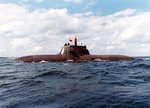October 9, 2007: Italy and Germany have each deployed one of their new Type 212 submarines to counter-terror duties in the Mediterranean. The boats in question, using their air-independent propulsion, can spend a week or more underwater, stalking transport ships suspected of participating in terrorist operations.
A new generation of non-nuclear submarines like the Russian Amur/Lama, the French Scorpene, and the German Type 212, have been entering service in the last few years. Unlike past non-nuclear submarines, which used diesel-electric plants, these new boats use fuel cells or other forms of air-independent propulsion. Germany commissioned its first Type 212 boat, using air-independent propulsion, two years ago. Four of these are being built. These are special boats, as they possess fuel cells (or AIP, Air Independent Propulsion) , which enable them to quietly operate underwater for weeks at a time. They still have diesel propulsion, but this is only used for surface travel. The 212s are also very quiet, quieter than most nuclear boats in service. This makes them an even match for a current nuclear boat equipped with better sensors. The 1,500 ton 212s are much smaller than nuclear boats (188 feet long, compared to 360 feet and 6,200 tons for the new U.S. Virginia class SSNs). The nuclear boats are used for a lot more than hunting other ships, and subs, while the 212s are mainly attack boats, and well designed and equipped for it.
While Germany is an American ally, their development of fuel cell technology for subs, and use of these boats in their own navy, are making this technology mature, and eventually available to many more nations. These 212 boats are, expensive (about half a billion dollars each), but that's less than a third the cost of a nuclear boats. The 212s are also highly automated, requiring a crew of only 27. But with six torpedo tubes, and a dozen torpedoes (plus anti-ship missiles, launched from the tubes, as well as mines), they could be, in the wrong hands, a major threat to the U.S. fleet. Cheaper to buy, cheaper to run (you don't need as many skilled sailors for the crew) and very lethal, American admirals are watching very closely who the Germans export these boats to.
Bundeswehr Marine Submarine Type 212
Technical Specifications
Length/Beam/Draft (m): 56,0/6,8/6,4
Displacement: 1,450 tons
Speed: approx. 17 knots
Drive Line
Propulsive Power: Fuel Cells / batteries
Armament
6 torpedo tubes
Complement
approx. 27
A new generation of non-nuclear submarines like the Russian Amur/Lama, the French Scorpene, and the German Type 212, have been entering service in the last few years. Unlike past non-nuclear submarines, which used diesel-electric plants, these new boats use fuel cells or other forms of air-independent propulsion. Germany commissioned its first Type 212 boat, using air-independent propulsion, two years ago. Four of these are being built. These are special boats, as they possess fuel cells (or AIP, Air Independent Propulsion) , which enable them to quietly operate underwater for weeks at a time. They still have diesel propulsion, but this is only used for surface travel. The 212s are also very quiet, quieter than most nuclear boats in service. This makes them an even match for a current nuclear boat equipped with better sensors. The 1,500 ton 212s are much smaller than nuclear boats (188 feet long, compared to 360 feet and 6,200 tons for the new U.S. Virginia class SSNs). The nuclear boats are used for a lot more than hunting other ships, and subs, while the 212s are mainly attack boats, and well designed and equipped for it.
While Germany is an American ally, their development of fuel cell technology for subs, and use of these boats in their own navy, are making this technology mature, and eventually available to many more nations. These 212 boats are, expensive (about half a billion dollars each), but that's less than a third the cost of a nuclear boats. The 212s are also highly automated, requiring a crew of only 27. But with six torpedo tubes, and a dozen torpedoes (plus anti-ship missiles, launched from the tubes, as well as mines), they could be, in the wrong hands, a major threat to the U.S. fleet. Cheaper to buy, cheaper to run (you don't need as many skilled sailors for the crew) and very lethal, American admirals are watching very closely who the Germans export these boats to.
Bundeswehr Marine Submarine Type 212
Technical Specifications
Length/Beam/Draft (m): 56,0/6,8/6,4
Displacement: 1,450 tons
Speed: approx. 17 knots
Drive Line
Propulsive Power: Fuel Cells / batteries
Armament
6 torpedo tubes
Complement
approx. 27


